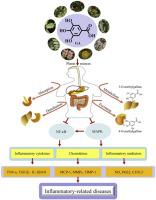Biomedicine & Pharmacotherapy ( IF 6.9 ) Pub Date : 2020-11-16 , DOI: 10.1016/j.biopha.2020.110985 Jinrong Bai , Yunsen Zhang , Ce Tang , Ya Hou , Xiaopeng Ai , Xiaorui Chen , Yi Zhang , Xiaobo Wang , Xianli Meng

|
Gallic acid (GA), also known as 3,4,5-trihydroxybenzoic acid, is a natural secondary metabolite and widely isolated from various fruits, plants and nuts. In recent years, GA has received increasing attention for its powerful anti-inflammatory properties. The purpose of this review is to clearly illuminate the pharmacological activities and related molecular mechanisms of GA in inflammatory diseases. After consulting a large number of literatures, we made a comprehensive exposition on the chemical characteristics, plant origins, pharmacokinetics and toxicity of GA, especially its pharmacological activities and mechanisms of action. Although the plant source of GA is very rich, its lower extraction rate limits the application of GA in development. It is worth mentioning that GA can not only be separated from many plants, but also be produced in large quantities through biological and chemical synthesis. According to pharmacokinetic studies, the absorption and elimination of GA after oral administration are fast, while the structural optimization or dosage form adjustment of GA is beneficial to increase its bioavailability. Promisingly, toxicity studies have shown that GA scarcely has obvious toxicity or side effects in a variety of animal experiments and clinical trials. The results show that the anti-inflammatory mechanisms of GA mainly involved MAPK and NF-κB signaling pathways. It thus weakens the inflammatory response by reducing the release of inflammatory cytokines, chemokines, adhesion molecule and cell infiltration. Due to its excellent pharmacological activities, GA is expected to be a potential candidate for the treatment of various inflammation-related diseases. This paper will provide theoretical basis for the clinical application of GA and guide the future research and medicinal development of GA.
中文翻译:

没食子酸:与炎症相关疾病的药理活性和分子机制
没食子酸(GA),也称为3,4,5-三羟基苯甲酸,是一种天然的次生代谢产物,广泛地从各种水果,植物和坚果中分离出来。近年来,GA因其强大的抗炎特性而受到越来越多的关注。这篇综述的目的是清楚地阐明GA在炎性疾病中的药理活性和相关的分子机制。在查阅了大量文献后,我们对GA的化学特性,植物来源,药代动力学和毒性,特别是其药理活性和作用机理作了全面论述。尽管GA的植物来源非常丰富,但其较低的提取率限制了GA在开发中的应用。值得一提的是,GA不仅可以与许多植物分离,而且还可以通过生物和化学合成大量生产。根据药代动力学研究,口服后GA的吸收和清除速度很快,而GA的结构优化或剂型调整有利于提高其生物利用度。可能的是,毒性研究表明,GA在各种动物实验和临床试验中几乎没有明显的毒性或副作用。结果表明,GA的抗炎机制主要涉及MAPK和NF-κB信号通路。因此,它通过减少炎性细胞因子,趋化因子,粘附分子和细胞浸润的释放来减弱炎性反应。由于其出色的药理活性,GA有望成为治疗各种炎症相关疾病的潜在候选药物。本文将为遗传算法的临床应用提供理论依据,并指导遗传算法的未来研究和医学发展。






























 京公网安备 11010802027423号
京公网安备 11010802027423号